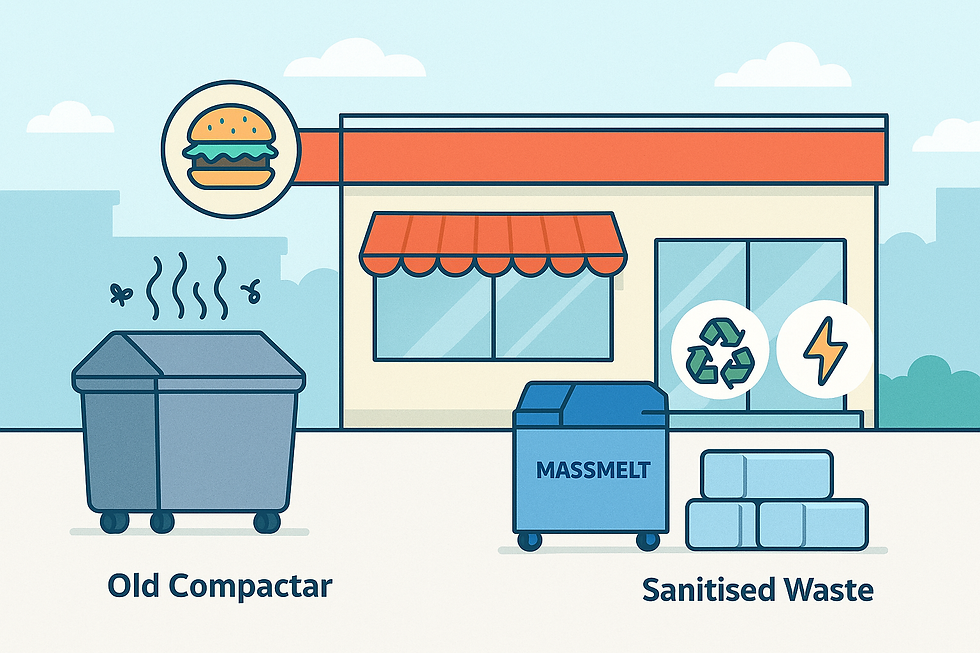Why can’t most plastic be recycled?
- dscheeres
- Sep 6
- 3 min read
Most plastics can’t be recycled because they are too contaminated, made from mixed polymers, or economically unviable to process.
Addressing how to deal with plastic waste no one recycles requires innovation beyond traditional recycling systems, new waste-to-resource models, and industry-specific solutions.
Why Can’t Most Plastic Be Recycled?
Recycling is often presented as a simple act: throw plastic in the right bin, and it will be turned into something new. In reality, only about 9% of global plastic waste has ever been recycled.
The majority is burned, landfilled, or dumped, especially in developing countries.
What Are the Key Barriers?
Material complexity
Many plastics are made from multiple polymer layers fused together (e.g., crisp packets, laminated packaging).
These cannot be easily separated, making them unsuitable for conventional recycling.
Contamination issues
Plastics contaminated with food, chemicals, or medical use are rejected.
Blue wraps, gowns, and drapes from hospitals are good examples of recyclable materials that end up incinerated.
Economic feasibility
Virgin plastic is cheaper and more consistent than recycled plastic.
Manufacturers often prefer new materials, reducing demand for recyclates.
Infrastructure gaps
Recycling systems are not designed to handle every plastic type.
In many countries, weak waste management leads to illegal dumping and burning.
The result? Most plastics join the growing mountains of waste. Solving this means focusing on how to deal with plastic waste no one recycles.

Which Plastics Are the Hardest to Recycle?
Single-Use & Medical Plastics
One of the hardest categories is blue polypropylene sterilization wrap, used widely in hospitals. Despite being a recyclable polymer, it is:
Classified as “clinical waste.”
Expensive to treat, usually incinerated.
Produced in enormous volumes.
This makes recycling blue wrap from hospitals a critical challenge in building a circular economy.
Composite & Hard Plastics
Another tough category is hard and composite plastics, including:
Laminated food packaging that combines foil and polymer.
Rigid, thick plastics such as casings or heavy packaging.
Plastics with colorants or chemical additives.
Businesses generating these need a commercial waste solution for hard plastics—one that goes beyond landfill or incineration.
How to Build a Medical Waste Circular Economy
The concept of a circular economy is about keeping materials in use for as long as possible. In healthcare, this means:
Recycling blue wrap from hospitals into usable products.
Creating new applications like outdoor furniture, building materials, or 3D-printing filament.
Reducing dependency on virgin plastics.
By rethinking waste as a resource, hospitals and industries can adopt a zero landfill waste model that cuts emissions and recovers value.
Traditional Recycling vs. Advanced Waste Solutions
Feature | Traditional Recycling | Advanced Onsite Recycling Solutions |
Contamination Handling | Rejects medical & food plastics | Sanitizes and reprocesses onsite |
Material Types | Limited to clean rigid plastics | Designed for hard & specialized plastics |
Volume Reduction | Moderate | Up to ~85% shrinkage into blocks |
Business Benefit | Disposal costs only | Creates valuable secondary raw material |
Circularity | Low | Integrated into medical waste circular economy |
How to Deal With Plastic Waste No One Recycles
The path forward requires innovation and system-level change. Some strategies include:
Onsite recycling technologies – Treating plastics where they are generated, reducing transport and contamination.
Industry-specific solutions – Hospitals, airports, and factories need tailored recycling models.
Partnerships for reuse – Collaboration with manufacturers to reintroduce recycled plastics into products.
Policy support – Governments must incentivize recycling through regulation and investment.
Scaling circular economy models – Moving from disposal to reuse as the default option.
These approaches provide concrete answers to how to deal with plastic waste no one recycles.
Towards a Zero-Waste Future
Most plastics are not recycled because they are complex, contaminated, or economically unattractive. From hospital blue wraps to rigid, composite plastics, these streams form the bulk of what ends up in incinerators and landfills, but solutions are emerging.
By focusing on commercial waste solutions for hard plastics and embedding recycling into a medical waste circular economy, industries can turn problems into resources.
The real challenge of our time is not just recycling the easy plastics—it’s figuring out how to deal with plastic waste no one recycles. And with innovation, collaboration, and circular thinking, that future is within reach.
FAQs
1. Why can’t traditional recycling handle hospital blue wrap?
It’s considered contaminated medical waste. Advanced onsite recycling solutions sanitize and recycle it safely.
2. How does advanced recycling reduce waste disposal costs?
By shrinking waste volume and eliminating the need for incineration, hospitals and businesses save significantly.
3. Can hard plastics be reused in new industries?
Yes, processed briquettes and recycled plastics can be turned into building materials, furniture, or 3D-printing filament.
4. What is a medical waste circular economy?
It’s a system where hospital plastics, like blue wrap, are continuously recycled into valuable resources instead of being incinerated or landfilled.











Comments